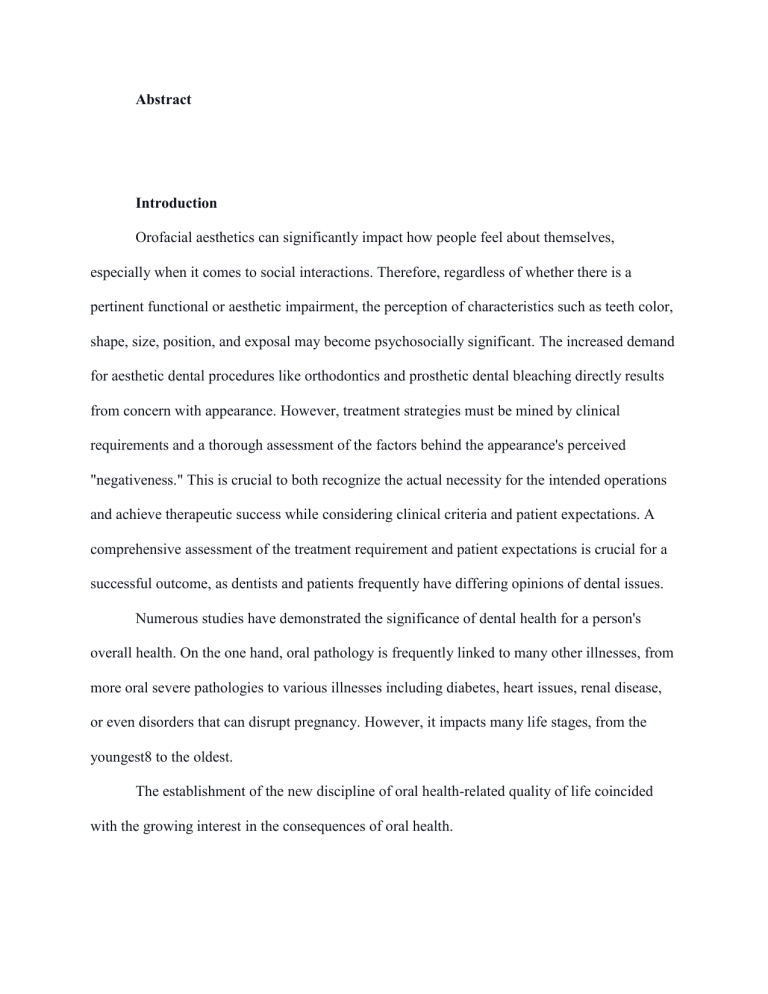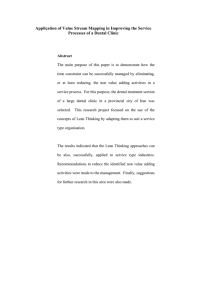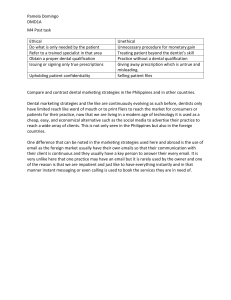
Abstract Introduction Orofacial aesthetics can significantly impact how people feel about themselves, especially when it comes to social interactions. Therefore, regardless of whether there is a pertinent functional or aesthetic impairment, the perception of characteristics such as teeth color, shape, size, position, and exposal may become psychosocially significant. The increased demand for aesthetic dental procedures like orthodontics and prosthetic dental bleaching directly results from concern with appearance. However, treatment strategies must be mined by clinical requirements and a thorough assessment of the factors behind the appearance's perceived "negativeness." This is crucial to both recognize the actual necessity for the intended operations and achieve therapeutic success while considering clinical criteria and patient expectations. A comprehensive assessment of the treatment requirement and patient expectations is crucial for a successful outcome, as dentists and patients frequently have differing opinions of dental issues. Numerous studies have demonstrated the significance of dental health for a person's overall health. On the one hand, oral pathology is frequently linked to many other illnesses, from more oral severe pathologies to various illnesses including diabetes, heart issues, renal disease, or even disorders that can disrupt pregnancy. However, it impacts many life stages, from the youngest8 to the oldest. The establishment of the new discipline of oral health-related quality of life coincided with the growing interest in the consequences of oral health. According to WHO, the perceived influence of pain, discomfort, and physical, psychological, and social functioning on a person's wellbeing is known as oral-health-related quality of life (OHRQoL). The investigation of the connection between the quality of life and oral health is further complicated by the fact that, as Slate12 notes, "[the] ideas of health and quality of life are elusive and abstract; while we know instinctively what they imply, they are difficult to describe." In the past, the view on general health comprised broad category influences, such as those that are behavioral, environmental, and economic in origin. Nevertheless, this viewpoint has become more complicated throughout time and now considers biological, social, and psychological issues. Recent studies have produced factual proof that dental health is strongly and favorably related to both physical and mental health. Maintaining excellent dental health in connection to overall wellness is crucial, say, Gluck and Morganstein, since being healthy entail more than just being disease-free. Even though relatively few investments would produce lasting advantages, preventative measures have not yet been fully adopted in the case of oral health. Furthermore, despite its significance, the integration of oral health into primary care is still a relatively new practice in the realm of health care services. This paper seeks to confirm that Esthetic dentistry done on patients with low self-esteem has shown improvements in self-confidence. Literature review Oral health, life satisfaction, and self-worth The literature frequently mentions the connection between good dental health and selfesteem. Numerous studies have found a link between good dental health and self-esteem. Due to their effects on aesthetics and psychosocial functioning, several oral diseases, such as malocclusions, anterior traumatic teeth, tooth loss, and untreated decay, negatively influence one's sense of self-worth. 34 Additionally, it was discovered that self-esteem was adversely correlated with negative affect, worse OHRQoL, and lower OHRQoL levels. Additionally, selfesteem was correlated with particular mental diseases like alcoholism and favorably with academic achievement in school. Studies that take a more psychological approach to the person's oral health-related behaviors also emphasize the significance of self-esteem as a connected psychological construct. Self-esteem, together with other self-constructs including self-confidence, self-competence, selfliking, self-control, and perfectionism, may be successfully modeled as a predictor of oral healthrelated behaviors. Similar, favorable associations were discovered in other research examining the relationship between self-esteem and oral health-related activities. Self-esteem was found to moderate "protectively" the impact of treatment, and the resulting improvement in oral health can result in improved self-esteem. Furthermore, while dental treatment in children, such as orthodontic therapy, may be associated with a deterioration of the overall perceived oral-healthrelated quality of life, self-esteem was found to moderate "protectively" the impact of treatment. It has been demonstrated that both self-rated general health and oral health-related dental health positively impact life satisfaction and self-esteem. Oral health, life satisfaction, and wellbeing The quality of life, particularly oral health issues, and general oral health have been demonstrated to be significantly correlated. For instance, conditions that affect the quality of life include edentulism, malocclusions, orthodontic treatment, periodontitis, dental implants, removable dental prosthetics, and more. Dental issues in early infancy could substantially impact young children's oral health, their quality of life, and that of their families. The long-term dangers they pose for permanent teeth are added to this. Further research revealed a good relationship between children's dental health and social and emotional development, mental health, and family functioning. Other research that focused on a particular disease discovered that teenagers with malocclusion had a worse quality of life, with the emotional and social aspects of wellbeing being most significantly impacted. It is crucial to remember that dental health affects everyone's general wellbeing, not just kids and teenagers. Brennan and colleagues discovered that oral health was significant along with overall health, living circumstances, and reliance on research that included people over . According to another study, a friendly face is equivalent to a letter of recommendation. It has long been believed that a person's look has a lasting influence on how other people perceive them. Our society's obsession with beauty has a significant sign influence and our thinking. The media projects the ideal appearance. Additionally, it has boosted the public's need for aesthetic treatments. An essential aspect of facial attractiveness is the dental look. The look of one's teeth might influence the conclusions one draws about the personality traits of others. Some professional associations believe distinguished careers necessitate attractive dental aesthetics. In developed countries, there are established standards for facial aesthetics, and excessive standard variations are seen as inappropriate. The placement of a restoration that enhances dental appearance benefits a patient's quality of life and sense of self. Oral health includes its impact on a subject's social life and dentofacial self-confidence, in addition to the absence of oral illness and dysfunction. This is consistent with how the WHO defines the quality of life. Dental phobia, oral health, and quality of life According to the study by Vigu & Stanciu (2019), Dental pain was discovered to have a worsening effect on people due to dental anxiety, which was linked to decreased OHRQoL in adults and children. It may not be a coincidence that dental anxiety is positively correlated with postponing actual dental care and appointments with the dentist, which in turn positively predicts low levels of oral health, given the frequent cohabitation of pain and poor oral health status. However, in adults and children, there were direct, unmediated relationships between dental phobia and the quality of life associated with oral health. According to a recent study by Costa et al., general anxiety symptoms, rather than dental anxiety specifically, directly impact young women's perceptions of their oral health. Regarding particular illnesses, the presence of chronic periodontitis is linked to higher levels of dental phobia and poorer levels of OHRQoL. Regarding the overall quality of life, a study on dental fear and anxiety in displaced people in Bosnia and Herzegovina found that vulnerable people are more likely to experience higher levels of dental fear, poor oral health status, fewer dental visits, and urgent dental treatment needs. The study also found that poor oral health and dental fear may mutually influence each other. In addition to coping with greater dental dread, inadequate coping mechanisms, and other economic and social problems, vulnerable individuals, such as those who suffer from mental illnesses, are more likely to have lower oral health. Despite clearly defined susceptible populations, dental fear was a sign of dental health issues, or poor oral health, combined with sociodemographic challenges and behavior management issues. For instance, a strong relationship between greater oral behavior activation, trait anxiety, and self-reported temporomandibular problems was discovered. Science has shown, however, that effective communication with the dentist reduces dental anxiety and is positively related to improved levels of oral health. Additionally, it was shown that cognitive behavioral therapy was successful in lowering young patients' dental anxiety. Methodology The paper conducts a literature review of four studies by Afroz et al., 2013, Campos et al., 2020; Kaur, 2017; and Vigu & Stanciu, 2019. Results According to the study by Campos et al. (2020), economic situation, dentition state, dental aesthetic therapy, and admiration of one's smile contributed significantly to the psychological effects of dental aesthetics. The study also found that those from lower socioeconomic backgrounds are more influenced by oral health, suggesting that access to healthcare may be directly impacted by poverty. Additionally, there are differences between different income levels in terms of an individual's health-related psychological and psychosocial resources, such as their capacity to develop coping mechanisms, appropriate social support, and social control. Additionally, the psychological effects of dental aesthetics were not significantly influenced by age or sexual orientation. A more substantial impact of dental appearance on people's lives was shown by seeking dental aesthetics therapy and enjoying one's smile. When a problematic feature is altered or removed during an aesthetic operation, the patient's perception of the feature likewise changes, and the treatment meets the patient's expectations. However, liking one's smile lessens the psychosocial influence dental aesthetics might have on a person's life. Participants with one or more missing teeth experienced a more significant psychological impact from dental aesthetics; however, wearing a prosthesis did not affect this impact. The psychological effects of tooth loss have not been studied. However, it is well known that tooth loss significantly influences oral health-related quality of life, and the impact increases with the number and location of missing teeth. The study identified traits that strongly contribute to the psychological impact of dental aesthetics, providing evidence that can enhance clinical treatment. The treatment of a patient may be based on the patient's expectations for the effectiveness of the therapy and the patient's clinical requirements. Findings by Vigu & Stanciu (2019) offer further concrete proof of the necessity for improved oral health preventive programs and detailed teaching in the utilization of dental care services and self-care practices. This additional information on the significant impact that selfesteem plays on both oral health-related wellbeing and general well-being may be helpful to physicians and health policymakers. To comprehend the influence on a person's life, efforts are needed and appreciated to consider the patients' self-esteem, starting with thorough explanations of the therapy and appropriate bedside manners. Additionally, dental dread, a type of particular anxiety, has an effect on people's oral health as well as their sense of self-worth. As a result, it is an issue that must be considered in all interactions between the patient and the dental care system. Although it stands to reason that potential patients would be more cooperative if they were less anxious about going to the dentist, our findings prove that better dental-specific wellbeing and self-esteem are related to less particular anxiety. The study also supported the idea that when creating intricate models of how oral health impacts overall wellbeing, oral activities that have the potential to cause TMJ problems should be taken into account. The findings of Kaur's study from 2017 demonstrated a substantial correlation between self-esteem and perceived dental aesthetics, with those who thought they were "less beautiful" scoring lower on self-esteem tests than those who thought they were "pretty." This suggests that self-perceived aesthetics may have an impact on self-esteem. Based on the study by Afroz et al. (2013), it can be deduced that a person's perception of their dental esthetics significantly impacts their social and psychological wellbeing, which is reflected in their behavior and can lower their sense of self-worth. However, there are certain restrictions on this study. Because the study's cohort of participants was young, there is a chance that some of them may have already undergone cosmetic dental work. The disparity between the final findings of overall happiness with dental appearance and the contentment with the various aspects of smile might have been caused by this. https://bmcoralhealth.biomedcentral.com/articles/10.1186/s12903-021-01509-z




